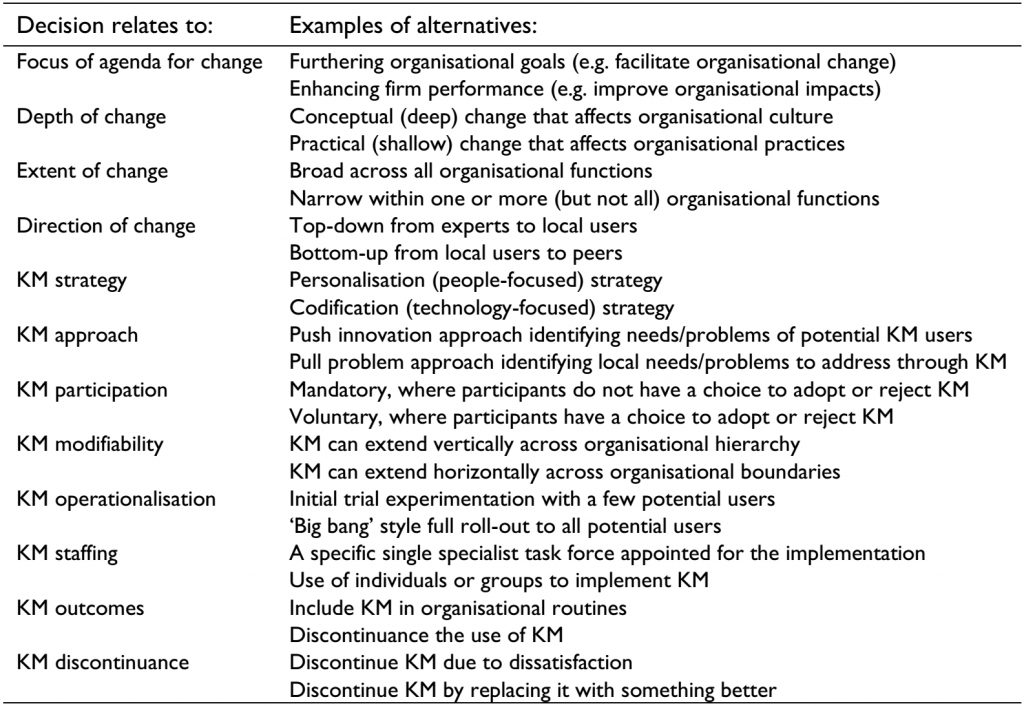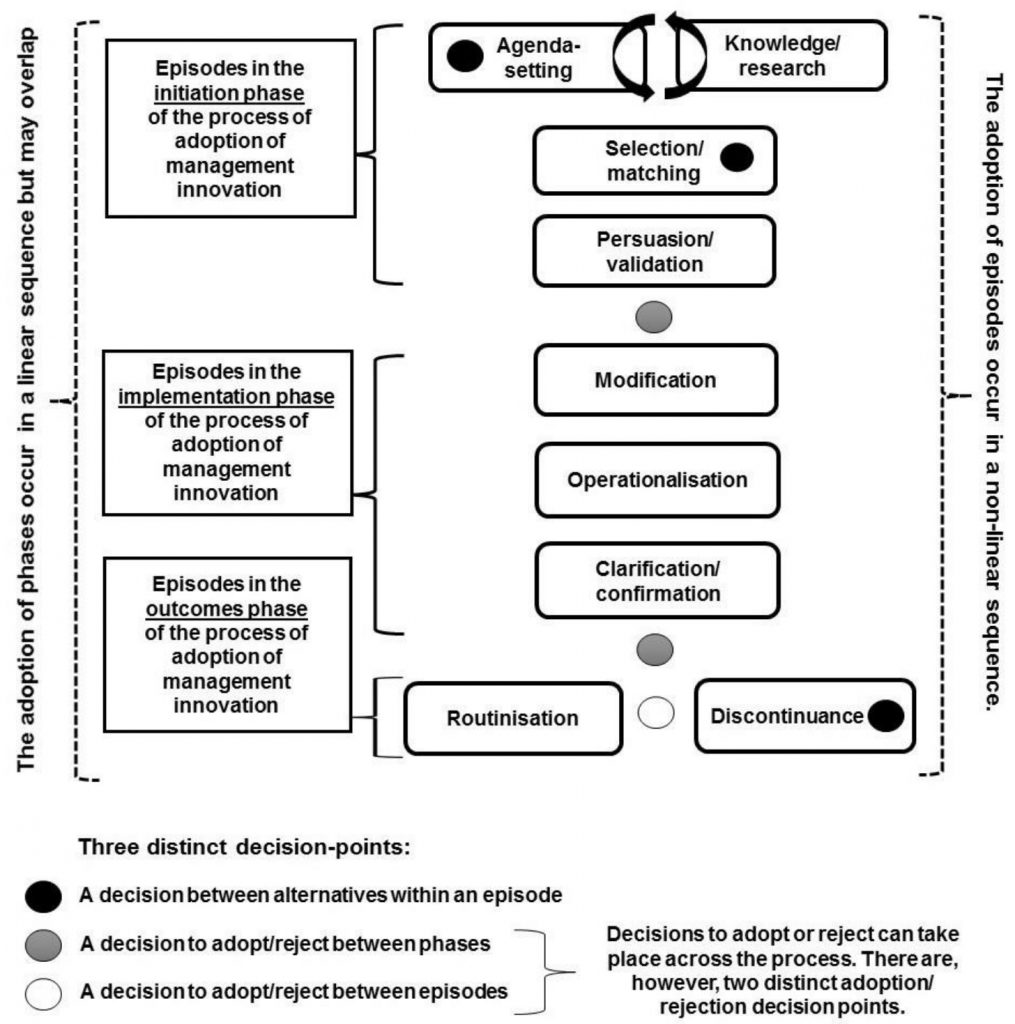
The adoption process in management innovation: A knowledge management case study
A recent paper1 draws on the findings of a longitudinal study of the adoption of knowledge management as a management innovation in an organisational setting. The case study organisation is a large distributed public sector organisation in Europe.
The paper begins with a literature review presenting KM as a management innovation, with reference to earlier theoretical models of the process of adoption of management innovation and consideration of decision-making as a key activity throughout the adoption process. The case study is then examined, with discussion of the adoption of KM across the three phases of initiation, implementation, and outcomes. Each of the three phases was found to comprise several episodes, with decision-making occurring across all three phases. The case study findings are then considered with reference to the literature review, facilitating extension of a proposed model of the process of adoption of a management innovation.
Literature review
Numerous studies have looked at the role of KM in innovation processes, but few studies have looked at KM as an innovation in it’s own right. However, KM can be considered a management innovation on the basis of sharing the four main characteristics of management innovation: exhibits novelty/newness, implemented in practice, intended to further organisational goal, and impacts on how managerial work is conducted.
There are the two main processes associated with innovation at an organisational level, ‘generation’ and ‘adoption’. Previous research into management innovation has looked mainly at generation, and there is a lack of in-depth knowledge of adoption. While adoption is discussed in the literature, there are a lack of studies examining the entire adoption process in detail.
Innovation models were examined, and five with relevance were combined into a consolidated model of the adoption process that could be tested in practice in a case study organisation. Two of the models show that decisions to adopt or reject an innovation can take place at a number of points across the adoption process. In the case of KM, there are many decisions between alternatives to consider, as shown in the following table.

Decisions between alternatives for the adoption of KM as a management innovation (Source: Rasmussen & Hall 2016)
Case study analysis
The case study organisation was PuSA, a large national public sector agency responsible for economic development in a European country. In the study, data was collected and analysed for a longitudinal timeframe of 13 years (1995-2008). Electronic sources for the full 13-year period were used, together with participant observations made over five of these years.
As shown in the following table, the case study confirmed the three distinct phases of the consolidated model of the adoption process that had been developed in the literature review, and facilitated the refining of the episodes within each phase.

Phases and episodes of management innovation identified in the study
(Source: Rasmussen & Hall 2016)
A further key finding is that the phases and episodes have to be considered separately, however the phases may overlap. The findings confirm that decision-making in the adoption of a management innovation occurs at three points:
- Within episodes: decisions relate to organisational change, and/or to the management innovation in question (which, in this case, is KM).
- Between phases: decisions relate to further adoption or rejection of the management innovation, and in the case of further adoption lead into the transition from one phase to another.
- Between episodes: a decision to reject (or discontinue) after routinisation has occurred.
The case study analysis revealed that compatibility of decision making aids the adoption of KM as a management innovation, and that the adoption of a management innovation is threatened by a lack of compatibility across decision-making.
In this case decision-making in the agenda-setting and selection/matching episodes of the initiation phase that was incompatible with decision-making in the implementation phase had negative consequences at PuSA. For example, the decision to introduce a distributed KM task force that reported to different managers in different locations meant the focus of KM efforts was on delivering KM at a subsidiary, rather than, pan-organisational level. This was at odds with an established agenda for fostering knowledge sharing across the organisation. It also necessitated efforts to facilitate subsidiary delivery of KM in the modification episode of the implementation phase of adoption. These had corresponding negative impacts on the operationalisation and clarification/confirmation episodes. Difficulties were experienced in implementing KM in an environment where local practice differed in the subsidiaries. For example, there was great variety of how staffing was resourced in the subsidiaries where those in KM roles were recruited to different timescales, contracts, grades and salary scales and had a range of job titles, competencies, roles and measures of performance. In addition the purpose of the implementation was not well-understood due to the resulting mix of approaches adopted across different parts of the organisation. Such issues are further compounded in a management innovation when there is ad-hoc operationalisation in the absence of clear decision-making in the initiation phase. In this case no explicit decisions were made regarding KM strategy, the approach (pull or push), and degree of staff participation, nor to incorporate the KM tools into PuSA’s policies, processes or procedures. This put the adoption of the implementation as a whole at PuSA at risk.
Discussion
From the case study findings and literature review, an extended and refined model of the process of adoption of management innovation can generated, as shown in the following figure.

An extended and refined model of the process of adoption of a management innovation (Source: Rasmussen & Hall 2016)
The inclusion of ‘outcomes’ as an additional phase and ‘discontinuance’ as one of the episodes in this phase is notable, with models of innovation rarely considering failure as a possible outcome.
Reference:
- Rasmussen, L., & Hall, H. (2016). The adoption process in management innovation: A Knowledge Management case study. Journal of Information Science, 42(3), 356-368. ↩
Also published on Medium.






